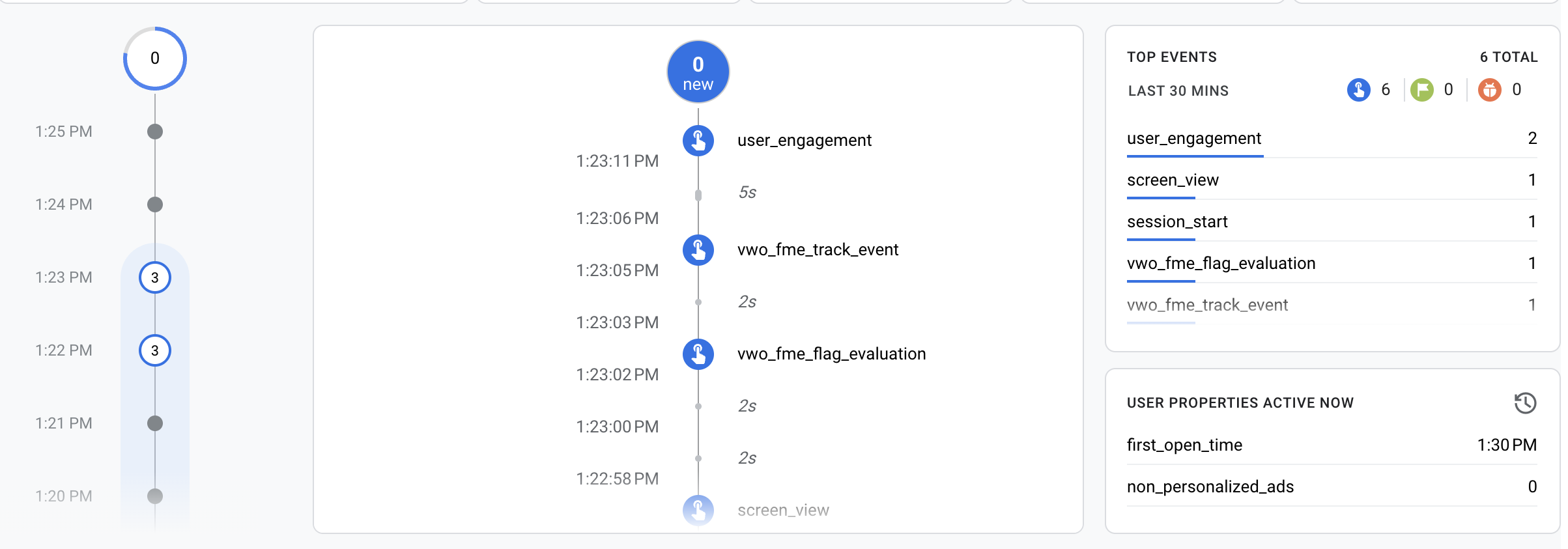Firebase Analytics
Overview
Firebase Analytics is a free, comprehensive analytics solution that provides detailed insights into app usage and user engagement. It offers automatic event tracking, reporting, audience segmentation, and seamless integration with other Firebase services, making it a powerful tool for understanding your app's performance and user behavior.
Integrating FE with Firebase Analytics offers significant benefits. FE sends feature flag and event data to Firebase Analytics, allowing you to see which feature flag variations users are exposed to directly within your Firebase dashboard. By correlating user behavior with specific experiments, you can gain deeper, data-driven insights into the real impact of your feature rollouts and campaigns.
Prerequisites
Firebase Analytics Setup
- Create a Firebase project at console.firebase.google.com if you don't already have one
- Add your iOS app to the Firebase project
- Download the
GoogleService-Info.plistconfiguration file - Add the configuration file to your Xcode project
- Follow the detailed setup instructions mentioned at Firebase iOS Setup Guide
VWO FE SDK Installation and Configuration
- Ensure you have the VWO Feature Experimentation product enabled for your VWO account
- The VWO FE SDK should be properly installed in your project
- Set your VWO account ID and SDK key in your application's configuration:
let FME_ACCOUNT_ID = "your_account_id" // Replace with your actual VWO account ID
let FME_SDK_KEY = "your_sdk_key" // Replace with your actual VWO sdk keyIntegration Steps
Firebase Analytics SDK integration enables automatic collection of feature flag data and user events. The example below shows an implementation with the iOS SDK.
NoteThe example below shows an implementation with the
iOSSDK. Please note that any VWO FE SDK can be used.
1. Add Required Dependencies
Add the following to your Podfile:
pod 'Firebase/Analytics'
pod 'VWO-FE-iOS'2. Create Firebase Analytics Integration Class
Implement a class to handle Firebase Analytics integration and provide methods for tracking events and flag evaluations.
import VWO_FME
import FirebaseAnalytics
class FirebaseAnalyticsIntegration: IntegrationCallback {
func execute(_ properties: [String: Any]) {
// Extract event name and parameters from VWO properties
if let api = properties["api"] as? String {
switch api {
case "getFlag":
// Handle getFlag API
if let featureName = properties["featureName"] as? String,
let userId = properties["userId"] as? String {
// Log the event to Firebase Analytics
Analytics.logEvent("vwo_fme_flag_evaluation", parameters: [
"featureName": featureName,
"userId": userId
])
}
case "track":
// Handle track API
if let eventName = properties["eventName"] as? String {
// Log the event to Firebase Analytics
Analytics.logEvent("vwo_fme_track_event", parameters: ["name": eventName])
}
default:
break
}
}
}
}3. Initialize Firebase Analytics and set up the IntegrationCallback:
IntegrationCallback:Initialize your FirebaseAnalyticsIntegration instance and provide an implementation of the IntegrationCallback when initializing the FE SDK. IntegrationCallback is a mechanism that automatically forwards FE SDK events (like flag evaluations) to the desired analytics platform for real-time tracking and analysis.
// Example Integration Callback Setup
let integration = FirebaseAnalyticsIntegration()
let options = VWOInitOptions(sdkKey: FME_SDK_KEY, // Replace with your actual VWO sdk key
accountId: FME_ACCOUNT_ID, // Replace with your actual VWO account ID
integrations: integration)
VWOFme.initialize(options: options) { result in
switch result {
case .success:
print("VWO-FE initialized successfully")
case .failure(let error):
print("VWO-FE initialization failed: \(error)")
}
}Integration Data
The execute method of the IntegrationCallback receives a Map<String, Any> containing details about the VWO SDK action:
- For flag evaluations (i.e.
getFlag):
{
"featureName": "yourFlagName",
"featureId": 5,
"featureKey": "yourFlagKey",
"userId": "UserId",
"rolloutId": 789,
"rolloutKey": "rollout_checkout",
"rolloutVariationId": 1,
"experimentId": 321,
"experimentKey": "exp_checkout_test",
"experimentVariationId": 2
}- For event tracking (
trackEvent):
{
"eventName": "yourEventName",
"api": "track"
}Ensure you have added your Firebase configuration to your project as specified in the Prerequisites.
This setup ensures that every time a feature flag is evaluated or an event is tracked by the VWO SDK, the relevant data is automatically sent to your Firebase Analytics dashboard.
Sample Screenshot

How to see the data in Firebase Analytics
After integrating Firebase Analytics with your app, you can view the tracked data in the following ways:
-
Access Firebase Console:
- Log in to Firebase Console
- Select your project
- Navigate to the Analytics section
-
View Feature Flag Evaluations:
- Look for events named
vwo_fme_flag_evaluation - These events contain data about the feature flag and the User ID
- Look for events named
-
Track Custom Events:
- Find events named
vwo_fme_track_event - These events include details about the event
- Find events named
-
Analyze Data: Use Firebase Analytics tools to:
- Create audience segments based on feature flag exposure
- Monitor user engagement and retention metrics
- Track conversion rates and monitor feature flag performance
- Export data to BigQuery for advanced analysis
- Set up automated insights and anomaly detection
This is an example of an implementation using the iOS SDK. While this demonstrates the approach, you can utilize any of the VWO FE SDKs for your project.
Updated 4 months ago
